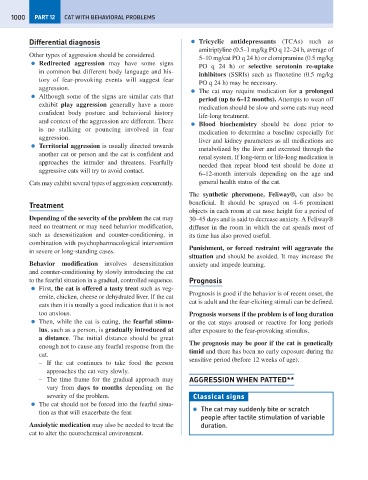Page 1008 - Problem-Based Feline Medicine
P. 1008
1000 PART 12 CAT WITH BEHAVIORAL PROBLEMS
Differential diagnosis ● Tricyclic antidepressants (TCAs) such as
amitriptyline (0.5–1 mg/kg PO q 12–24 h, average of
Other types of aggression should be considered.
5–10 mg/cat PO q 24 h) or clomipramine (0.5 mg/kg
● Redirected aggression may have some signs
PO q 24 h) or selective serotonin re-uptake
in common but different body language and his-
inhibitors (SSRIs) such as fluoxetine (0.5 mg/kg
tory of fear-provoking events will suggest fear
PO q 24 h) may be necessary.
aggression.
● The cat may require medication for a prolonged
● Although some of the signs are similar cats that
period (up to 6–12 months). Attempts to wean off
exhibit play aggression generally have a more
medication should be slow and some cats may need
confident body posture and behavioral history
life-long treatment.
and context of the aggression are different. There
● Blood biochemistry should be done prior to
is no stalking or pouncing involved in fear
medication to determine a baseline especially for
aggression.
liver and kidney parameters as all medications are
● Territorial aggression is usually directed towards
metabolized by the liver and excreted through the
another cat or person and the cat is confident and
renal system. If long-term or life-long medication is
approaches the intruder and threatens. Fearfully
needed then repeat blood test should be done at
aggressive cats will try to avoid contact.
6–12-month intervals depending on the age and
Cats may exhibit several types of aggression concurrently. general health status of the cat.
The synthetic pheromone, Feliway®, can also be
Treatment beneficial. It should be sprayed on 4–6 prominent
objects in each room at cat nose height for a period of
Depending of the severity of the problem the cat may 30–45 days and is said to decrease anxiety. A Feliway®
need no treatment or may need behavior modification, diffuser in the room in which the cat spends most of
such as desensitization and counter-conditioning, in its time has also proved useful.
combination with psychopharmacological intervention
Punishment, or forced restraint will aggravate the
in severe or long-standing cases.
situation and should be avoided. It may increase the
Behavior modification involves desensitization anxiety and impede learning.
and counter-conditioning by slowly introducing the cat
to the fearful situation in a gradual, controlled sequence. Prognosis
● First, the cat is offered a tasty treat such as veg-
Prognosis is good if the behavior is of recent onset, the
emite, chicken, cheese or dehydrated liver. If the cat
cat is adult and the fear-eliciting stimuli can be defined.
eats then it is usually a good indication that it is not
too anxious. Prognosis worsens if the problem is of long duration
● Then, while the cat is eating, the fearful stimu- or the cat stays aroused or reactive for long periods
lus, such as a person, is gradually introduced at after exposure to the fear-provoking stimulus.
a distance. The initial distance should be great
The prognosis may be poor if the cat is genetically
enough not to cause any fearful response from the
timid and there has been no early exposure during the
cat.
sensitive period (before 12 weeks of age).
– If the cat continues to take food the person
approaches the cat very slowly.
– The time frame for the gradual approach may AGGRESSION WHEN PATTED**
vary from days to months depending on the
severity of the problem. Classical signs
● The cat should not be forced into the fearful situa-
● The cat may suddenly bite or scratch
tion as that will exacerbate the fear.
people after tactile stimulation of variable
Anxiolytic medication may also be needed to treat the duration.
cat to alter the neurochemical environment.

